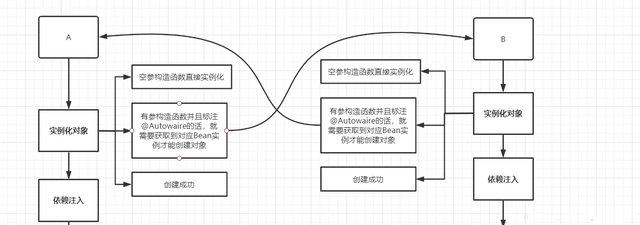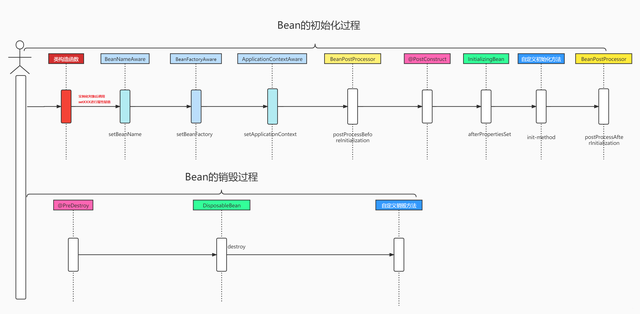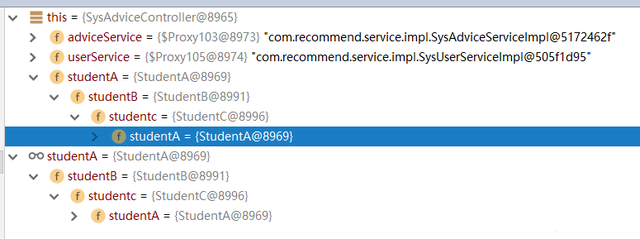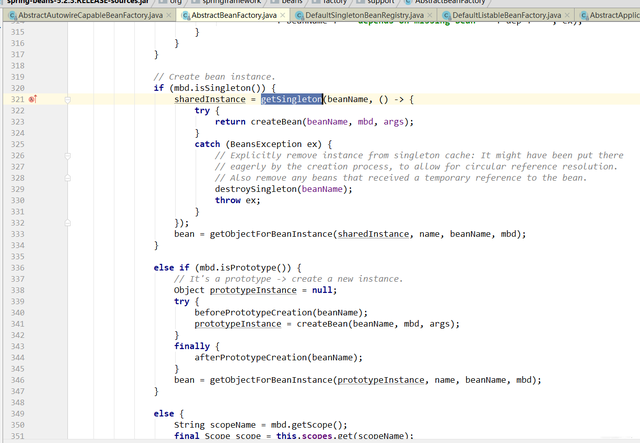什么是循环依赖?
循环依赖就是N个类中循环嵌套引用,如果在日常开发中我们用new 对象的方式发生这种循环依赖的话程序会在运行时一直循环调用,直至内存溢出报错。
那么Spring是如何解决循环依赖的?
【1】Spring循环依赖的三种方式
① 构造器参数循环依赖
Spring容器会将每一个正在创建的Bean 标识符放在一个“当前创建Bean池”中,Bean标识符在创建过程中将一直保持在这个池中,因此如果在创建Bean过程中发现自己已经在“当前创建Bean池”里时将抛出
BeanCurrentlyInCreationException异常表示循环依赖。而对于创建完毕的Bean将从“当前创建Bean池”中清除掉。
首先我们先初始化三个Bean。
public class StudentA {
private StudentB studentB ;
public void setStudentB(StudentB studentB) {
this.studentB = studentB;
}
public StudentA() {
}
public StudentA(StudentB studentB) {
this.studentB = studentB;
}
}
public class StudentB {
private StudentC studentC ;
public void setStudentC(StudentC studentC) {
this.studentC = studentC;
}
public StudentB() {
}
public StudentB(StudentC studentC) {
this.studentC = studentC;
}
}
public class StudentC {
private StudentA studentA ;
public void setStudentA(StudentA studentA) {
this.studentA = studentA;
}
public StudentC() {
}
public StudentC(StudentA studentA) {
this.studentA = studentA;
}
}也就是A依赖B,B依赖C,C依赖A。如果这时候创建实例A,将会抛出如下异常:
Caused by: org.springframework.beans.factory.BeanCurrentlyInCreationException:
Error creating bean with name 'a': Requested bean is currently in creation:
Is there an unresolvable circular reference?Spring容器先创建单例StudentA,StudentA依赖StudentB,然后将A放在“当前创建Bean池”中,此时创建StudentB,StudentB依赖StudentC ,然后将B放在“当前创建Bean池”中,此时创建StudentC,StudentC又依赖StudentA, 但是,此时StudentA已经在池
中,所以会报错,,因为在池中的Bean都是未初始化完的,所以会依赖错误 ,(初始化完的Bean会从池中移除)。
下图来源于网络

② set方法注入单例
如果要说setter方式注入的话,我们最好先看一张Spring中Bean实例化的图

如图中前两步骤得知:Spring是先将Bean对象实例化之后再设置对象属性的。
这时候我们再次获取StudentA对象将会成功获取到。
public class Test {
public static void main(String[] args) {
ApplicationContext context = new
ClassPathXmlApplicationContext("com/zfx/student/applicationContext.xml");
System.out.println(context.getBean("a", StudentA.class));
}
}那么为什么此时不会发生循环依赖异常呢?我们结合上面那张图看,Spring先是用构造实例化Bean对象 ,此时Spring会将这个实例化结束的对象放到一个Map中,并且Spring提供了获取这个未设置属性的实例化对象引用的方法。
结合我们的实例来看,当Spring实例化了StudentA、StudentB、StudentC后,紧接着会去设置对象的属性,此时StudentA依赖StudentB,就会去Map中取出存在里面的单例StudentB对象,以此类推,不会出现循环的问题。
我们常用的可能是如下方式:
@Component
public class StudentA {
@Autowired
StudentB studentB;
}
@Component
public class StudentB {
@Autowired
StudentC studentc;
}
@Component
public class StudentC {
@Autowired
StudentA studentA;
}
// 如下测试代码
@Api(tags = {"意见反馈"})
@Controller
@RequestMapping({"/advice","home/advice"})
public class SysAdviceController {
@Autowired
StudentA studentA;
@ResponseBody
@RequestMapping("/test")
public ResponseBean test(){
System.out.println("************************"+studentA);
return ResultUtil.success();
}
//...
}这里我们可以看下获取的对象,其同样是完成了正常的实例化,并没有出现循环依赖异常。可以说这样属性注入本质与setXXX单例是一样的。

③ setter方式原型,prototype
scope="prototype" 意思是 每次请求都会创建一个实例对象。两者的区别是:有状态的bean都使用Prototype作用域,无状态的一般都使用singleton单例作用域。
这里直接说明测试结果:
Caused by: org.springframework.beans.factory.BeanCurrentlyInCreationException:
Error creating bean with name 'a': Requested bean is currently in creation:
Is there an unresolvable circular reference?对于“prototype”作用域Bean,Spring容器无法完成依赖注入,因为“prototype”作用域的Bean,Spring容器不进行缓存,因此无法提前暴露一个创建中的Bean。

【2】从源码角度看Spring如何解决循环依赖
Spring的三级缓存
其实这里要了解Spring的三级缓存。下面是
DefaultSingletonBeanRegistry中的一些常量:
- 一级缓存Map<String, Object> singletonObjects
- 二级缓存Map<String, Object> earlySingletonObjects
- 三级缓存Map<String, ObjectFactory<?>> singletonFactories
// 一级缓存,存放beanName和Bean instance
/** Cache of singleton objects: bean name to bean instance. */
private final Map<String, Object> singletonObjects = new ConcurrentHashMap<>(256);
// 三级缓存 bean name - -objectFactory
/** Cache of singleton factories: bean name to ObjectFactory. */
private final Map<String, ObjectFactory<?>> singletonFactories = new HashMap<>(16);
// 二级缓存,存放beanName和Bean instance early:早期的
/** Cache of early singleton objects: bean name to bean instance. */
private final Map<String, Object> earlySingletonObjects = new HashMap<>(16);
// 注册序列的bean名称--单例哦
/** Set of registered singletons, containing the bean names in registration order. */
private final Set<String> registeredSingletons = new LinkedHashSet<>(256);
// 正在创建的bean的名称
/** Names of beans that are currently in creation. */
private final Set<String> singletonsCurrentlyInCreation =
Collections.newSetFromMap(new ConcurrentHashMap<>(16));在[读书笔记]IOC容器的依赖注入详解我们看到了Bean创建的过程。

如上图所示,在doGetBean的方法中首先调用
DefaultSingletonBeanRegistry的getSingleton(java.lang.String, boolean)方法尝试拿到单例缓存(也就是前面创建的,但是还可能没有完全完成bean的实例化)。
getSingleton方法是用来急切地检查手动注册的单例缓存。其允许当前创建的单例暴露出去,用来解决循环依赖。
// AbstractBeanFactory#doGetBean
@Nullable
protected Object getSingleton(String beanName, boolean allowEarlyReference) {
// 从一级缓存里面获取
Object singletonObject = this.singletonObjects.get(beanName);
// 如果一级缓存获取不到,且beanName是正在创建的Bean
if (singletonObject == null && isSingletonCurrentlyInCreation(beanName)) {
// 对一级缓存加锁
synchronized (this.singletonObjects) {
//从二级缓存里面获取
singletonObject = this.earlySingletonObjects.get(beanName);
// allowEarlyReference 这里传入的是true 允许bean提前暴露
// 如果二级缓存里面没有,则从三级缓存获取工厂
if (singletonObject == null && allowEarlyReference) {
ObjectFactory<?> singletonFactory = this.singletonFactories.get(beanName);
if (singletonFactory != null) {
// 得到工厂生产的bean
singletonObject = singletonFactory.getObject();
// 放入二级缓存
this.earlySingletonObjects.put(beanName, singletonObject);
// 从三级缓存移除
this.singletonFactories.remove(beanName);
}
}
}
}
return singletonObject;
}如果这里获取到了会直接调用bean = getObjectForBeanInstance(sharedInstance, name, beanName, null);获取最终bean实例。然后判断是否需要格式化,之后返回。
如果这里获取不到,那么就会走创建流程。最终我们会在
AbstractAutowireCapableBeanFactory的doCreateBean方法中看到这样的关键几步:
// 创建对象
instanceWrapper = createBeanInstance(beanName, mbd, args);
//单例 允许循环引用 是当前正在创建的bean,则调用addSingletonFactory allowCircularReferences 默认为true
boolean earlySingletonExposure = (mbd.isSingleton() && this.allowCircularReferences &&
isSingletonCurrentlyInCreation(beanName));
if (earlySingletonExposure) {
if (logger.isTraceEnabled()) {
logger.trace("Eagerly caching bean '" + beanName +
"' to allow for resolving potential circular references");
}
// 放到三级缓存
addSingletonFactory(beanName, () -> getEarlyBeanReference(beanName, mbd, bean));
}
// 依赖注入,实例化后期处理
Object exposedObject = bean;
try {
// 属性赋值,解析依赖,循环依赖也发生在这个过程
populateBean(beanName, mbd, instanceWrapper);
// bean实例化的后置处理,比如beanpostprocessor init-method等
exposedObject = initializeBean(beanName, exposedObject, mbd);
}我们看下这个addSingletonFactory方法,这个方法让那些需要迫切注册单例,例如能够解析循环引用场景使用。
protected void addSingletonFactory(String beanName, ObjectFactory<?> singletonFactory) {
Assert.notNull(singletonFactory, "Singleton factory must not be null");
synchronized (this.singletonObjects) {//对一级缓存加锁
if (!this.singletonObjects.containsKey(beanName)) { //如果一级缓存不存在该bean
this.singletonFactories.put(beanName, singletonFactory);//放入三级缓存
this.earlySingletonObjects.remove(beanName);//从二级缓存移除
this.registeredSingletons.add(beanName);//放入bean名称
}
}
}这样当执行到populateBean时 ,如果两个对象相互依赖,那么当前对象(假设为A)的实例化就会触发另外一个对象(假设为B)的实例化。当B实例化时其又依赖了A就会从三级缓存(或二级缓存)获取A的引用完成实例化从而最终完成A的实例化。
那么二级缓存在这里面的作用呢?
假设AB相互依赖,AC相互依赖。那么B实例化后,就该进行C的实例化,这时C就可以从二级缓存来获取A的实例引用了,就不需要再从三级缓存获取工厂让其生产实例。
即假设只有AB相互依赖,其他对象不依赖AB时,这里二级缓存是没用的,一级和三级缓存起作用。
那么什么时候放入一级缓存呢?
仍旧在AbstractBeanFactory的doGetBean方法中。如下代码所示,首先运行createBean方法,其次会调用getSingleton方法。
// Create bean instance.
if (mbd.isSingleton()) {
sharedInstance = getSingleton(beanName, () -> {
try {
return createBean(beanName, mbd, args);
}
catch (BeansException ex) {
// Explicitly remove instance from singleton cache: It might have been put there
// eagerly by the creation process, to allow for circular reference resolution.
// Also remove any beans that received a temporary reference to the bean.
destroySingleton(beanName);
throw ex;
}
});
bean = getObjectForBeanInstance(sharedInstance, name, beanName, mbd);
}这里调用的getSingleton方法是getSingleton(String beanName, ObjectFactory<?> singletonFactory),如下所示如果未从一级缓存得到singletonObject ,那么其会调用addSingleton(beanName, singletonObject);方法。
public Object getSingleton(String beanName, ObjectFactory<?> singletonFactory) {
Assert.notNull(beanName, "Bean name must not be null");
synchronized (this.singletonObjects) {
Object singletonObject = this.singletonObjects.get(beanName);
if (singletonObject == null) {
if (this.singletonsCurrentlyInDestruction) {
throw new BeanCreationNotAllowedException(beanName,
"Singleton bean creation not allowed while singletons of this factory are in destruction " +
"(Do not request a bean from a BeanFactory in a destroy method implementation!)");
}
if (logger.isDebugEnabled()) {
logger.debug("Creating shared instance of singleton bean '" + beanName + "'");
}
beforeSingletonCreation(beanName);
boolean newSingleton = false;
boolean recordSuppressedExceptions = (this.suppressedExceptions == null);
if (recordSuppressedExceptions) {
this.suppressedExceptions = new LinkedHashSet<>();
}
try {
singletonObject = singletonFactory.getObject();
newSingleton = true;
}
catch (IllegalStateException ex) {
// Has the singleton object implicitly appeared in the meantime ->
// if yes, proceed with it since the exception indicates that state.
singletonObject = this.singletonObjects.get(beanName);
if (singletonObject == null) {
throw ex;
}
}
catch (BeanCreationException ex) {
if (recordSuppressedExceptions) {
for (Exception suppressedException : this.suppressedExceptions) {
ex.addRelatedCause(suppressedException);
}
}
throw ex;
}
finally {
if (recordSuppressedExceptions) {
this.suppressedExceptions = null;
}
afterSingletonCreation(beanName);
}
if (newSingleton) {
addSingleton(beanName, singletonObject);
}
}
return singletonObject;
}
}addSingleton(beanName, singletonObject);方法如下所示:
复制
protected void addSingleton(String beanName, Object singletonObject) {
synchronized (this.singletonObjects) {
// 放入一级缓存
this.singletonObjects.put(beanName, singletonObject);
// 从三级缓存移除
this.singletonFactories.remove(beanName);
// 从二级缓存移除
this.earlySingletonObjects.remove(beanName);
// 放入registeredSingletons中
this.registeredSingletons.add(beanName);
}
}




















 666
666











 被折叠的 条评论
为什么被折叠?
被折叠的 条评论
为什么被折叠?








